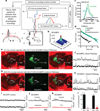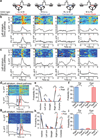Concurrent activation of striatal direct and indirect pathways during action initiation
- PMID: 23354054
- PMCID: PMC4039389
- DOI: 10.1038/nature11846
Concurrent activation of striatal direct and indirect pathways during action initiation
Abstract
The basal ganglia are subcortical nuclei that control voluntary actions, and they are affected by a number of debilitating neurological disorders. The prevailing model of basal ganglia function proposes that two orthogonal projection circuits originating from distinct populations of spiny projection neurons (SPNs) in the striatum--the so-called direct and indirect pathways--have opposing effects on movement: activity of direct-pathway SPNs is thought to facilitate movement, whereas activity of indirect-pathway SPNs is presumed to inhibit movement. This model has been difficult to test owing to the lack of methods to selectively measure the activity of direct- and indirect-pathway SPNs in freely moving animals. Here we develop a novel in vivo method to specifically measure direct- and indirect-pathway SPN activity, using Cre-dependent viral expression of the genetically encoded calcium indicator (GECI) GCaMP3 in the dorsal striatum of D1-Cre (direct-pathway-specific) and A2A-Cre (indirect-pathway-specific) mice. Using fibre optics and time-correlated single-photon counting (TCSPC) in mice performing an operant task, we observed transient increases in neural activity in both direct- and indirect-pathway SPNs when animals initiated actions, but not when they were inactive. Concurrent activation of SPNs from both pathways in one hemisphere preceded the initiation of contraversive movements and predicted the occurrence of specific movements within 500 ms. These observations challenge the classical view of basal ganglia function and may have implications for understanding the origin of motor symptoms in basal ganglia disorders.
Figures




Comment in
-
Neuroscience: To go or not to go.Nature. 2013 Feb 14;494(7436):178-9. doi: 10.1038/nature11856. Epub 2013 Jan 23. Nature. 2013. PMID: 23354047 No abstract available.
-
Neural circuits: stop 'n' go.Nat Rev Neurosci. 2013 Mar;14(3):158. doi: 10.1038/nrn3456. Epub 2013 Feb 13. Nat Rev Neurosci. 2013. PMID: 23403748 No abstract available.
-
Coactivation of direct and indirect pathways: insights into the basal ganglia and normal movement control.Mov Disord. 2013 May;28(5):582. doi: 10.1002/mds.25428. Mov Disord. 2013. PMID: 23677894 No abstract available.
References
-
- Albin RL, Young AB, Penney JB. The functional anatomy of basal ganglia disorders. Trends Neurosci. 1989;12:366–375. - PubMed
-
- DeLong MR. Primate models of movement disorders of basal ganglia origin. Trends Neurosci. 1990;13:281–285. - PubMed
-
- Mink JW. The Basal Ganglia and involuntary movements: impaired inhibition of competing motor patterns. Arch Neurol. 2003;60:1365–1368. - PubMed
-
- Hikosaka O, Takikawa Y, Kawagoe R. Role of the basal ganglia in the control of purposive saccadic eye movements. Physiol Rev. 2000;80:953–978. - PubMed
-
- Alexander GE, Crutcher MD. Functional architecture of basal ganglia circuits: neural substrates of parallel processing. Trends Neurosci. 1990;13:266–271. - PubMed
Publication types
MeSH terms
Substances
Grants and funding
LinkOut - more resources
Full Text Sources
Other Literature Sources
Molecular Biology Databases

